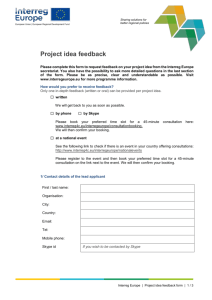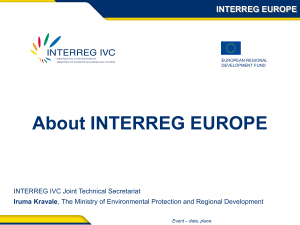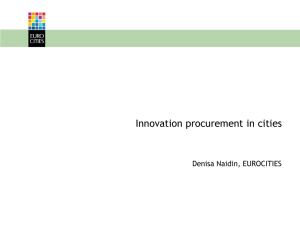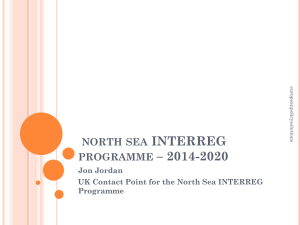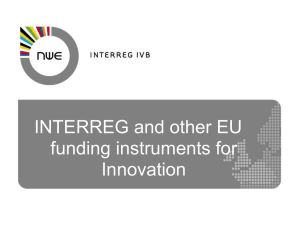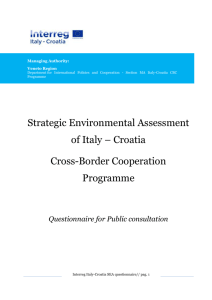Application Manual
advertisement
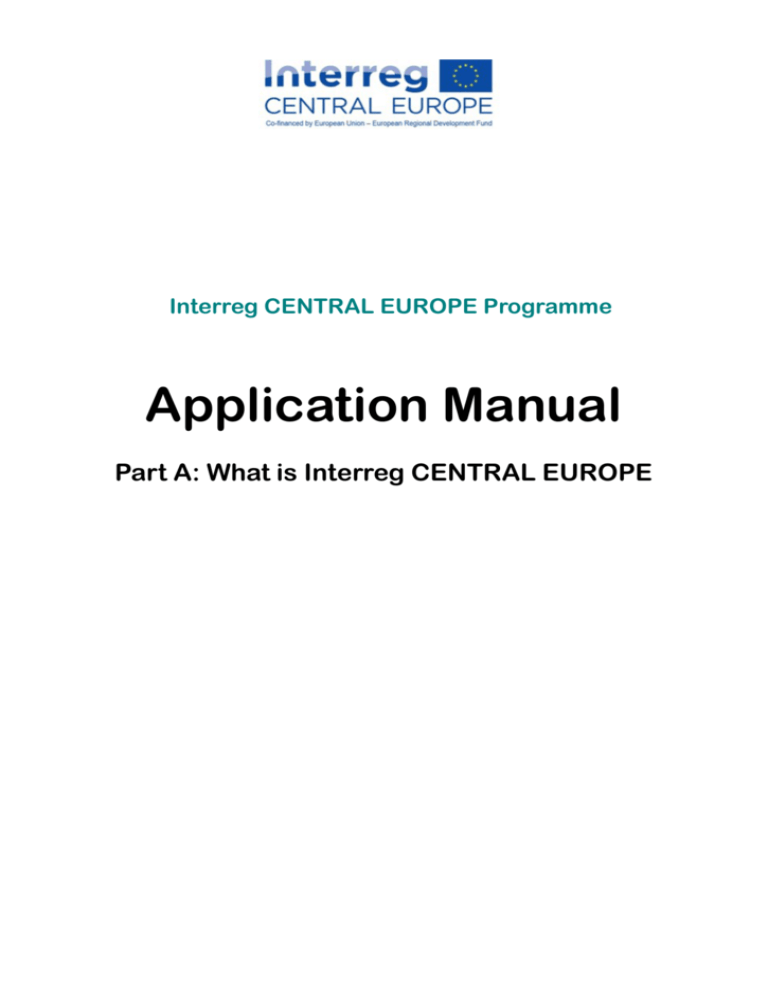
Interreg CENTRAL EUROPE Programme Application Manual Part A: What is Interreg CENTRAL EUROPE Part A What is Interreg CENTRAL EUROPE Content Part A What is Interreg CENTRAL EUROPE I. Interreg CENTRAL EUROPE: An overview A4 II. Programme area A4 III. Strategic priorities and specific objectives A5 IV. Programme budget A9 V. Legal framework and programme related documents A10 VI. Management structure A13 Part B What projects we are looking for Part C How to develop a good project Part D How to apply with us Part E What support we offer Annexes Part A What is Interreg CENTRAL EUROPE Table of abbreviations AF Application form BL Budget line eMS Electronic monitoring system ERDF European Regional Development Fund ETC European Territorial Cooperation LA Lead applicant LP Lead partner MA/JS Managing authority/joint secretariat MC Monitoring committee NCP National contact point PP Project partner SO Specific objective WP Work package Part A What is Interreg CENTRAL EUROPE I. Interreg CENTRAL EUROPE Programme: An overview The Interreg CENTRAL EUROPE Programme is funded by the European Regional Development Fund (ERDF) under the European Territorial Cooperation (ETC) objective, which supports regional cooperation among central European countries during the programming period 2014-2020. Key variables of the programme were agreed by the participating Member States following thorough consultations with relevant partners and stakeholders. They are described in detail in the Interreg CENTRAL EUROPE cooperation programme document, which was adopted by the European Commission on 16 December 2014. It can be downloaded from www.interreg-central.eu. In the following sections a brief overview is provided on the programme area, the strategic programme orientation, the programme budget and its management structure. However, the main source of information on several key aspects to be considered when preparing a project proposal remains the cooperation programme document. II. Programme area Compared to the 20072013 period, the programme area now covers also Croatia while western regions of Ukraine are not included any more. Covering an area of over 1 million square kilometres the Interreg CENTRAL EUROPE Programme is home to about 146 million people. The CENTRAL EUROPE programme area comprises the territory or parts of the territory of nine EU Member States. In total, the programme area is made up of 76 statistical NUTS 2 regions. The participating countries and regions are listed in the following table. Table 1 - Countries and regions participating in the Interreg CENTRAL EUROPE Programme Countries and regions Page A4 Austria Whole country Croatia Whole country Czech Republic Whole country Germany Baden-Württemberg, Bayern, Berlin, Brandenburg, Mecklenburg-Vorpommern, Sachsen, Sachsen-Anhalt, Thüringen Hungary Whole country Italy Emilia-Romagna, Friuli Venezia Giulia, Liguria, Lombardia, Piemonte, Provincia Autonoma Bolzano, Provincia Autonoma Trento, Valle d’Aosta, and Veneto Poland Whole country Slovak Republic Whole country Slovenia Whole country Central Europe is highly heterogeneous in geographical terms (marked by coastal areas, mountain ranges, rural areas, large urban agglomerations etc.) as well as in economic and social terms (exposing the lingering east-west divide). The programme area has a large number of assets but also faces numerous challenges in various fields affecting regional development, which have all been thoroughly analysed before concentrating the programme on four strategic priorities. Part A What is Interreg CENTRAL EUROPE Results expected from the programme will directly contribute to reaching goals of the Europe 2020 strategy. An in depth analysis of the programme territory as well of its strengths and weaknesses is available in the Interreg CENTRAL EUROPE cooperation programme document (cf. sections 1.1.1.2 and 1.1.1.3), which can be downloaded from www.interreg-central.eu. Figure 1 - Interreg CENTRAL EUROPE programme area III. Strategic priorities and specific objectives Projects to be funded will have to address one of the specific objectives of the programme as formulated under each priority axis. In direct response to the EU 2020 strategy for smart, sustainable and inclusive growth, the Interreg CENTRAL EUROPE Programme has formulated its overall programme objective as: ”Cooperating beyond borders in central Europe to make our cities and regions better places to live and work.” More precisely, transnational cooperation in central Europe is the catalyst for implementing smart solutions answering to regional challenges in the fields of innovation, low-carbon economy, environment, culture and transport. It builds regional capacities following an integrated bottom-up approach involving and coordinating relevant actors from all governance levels. In doing so, the programme will coordinate with other efforts in the regions including national and regional programmes supported by the European structural and investment funds (ESIF), macro-regional strategies, thematic EU programmes or the European Investment Bank (EIB). The programme builds on four priorities of particular relevance to central Europe. These are further broken down to specific objectives and respond to the programme area’s challenges and needs or build on opportunities identified in the analysis included in the Interreg CENTRAL EUROPE cooperation programme document. Page A5 Part A What is Interreg CENTRAL EUROPE Page A6 Figure 2 - Interreg CENTRAL EUROPE programme strategy, priority axes and specific objectives Part A What is Interreg CENTRAL EUROPE Priority axis 1 – “Cooperating on innovation to make CENTRAL EUROPE more competitive” Under this priority axis, the programme addresses key socio-economic challenges and needs within central Europe in relation to smart growth as defined in the Europe 2020 strategy. The priority aims at more effective investment in research, innovation and education. It will help strengthening potentials of technology-oriented areas that are destinations of foreign investments and capital flows, notably through better linking actors of innovation systems. This will enhance the transfer of research and development (R&D) results and the set-up of cooperative initiatives and clusters. It will also address regional disparities in knowledge and education such as brain drain, and strengthen capacities and competences for entrepreneurship and social innovation, also responding to challenges related to demographic change. The two specific objectives of this priority axis are: SO 1.1 To improve sustainable linkages among actors of the innovation systems for strengthening regional innovation capacity in central Europe More detailed information on the priority axes and specific objectives of the programme as well as examples of actions to be supported can be found in the cooperation programme document (section 2), available on www.interreg-central.eu and in annex I of this application manual. SO 1.2 To improve skills and entrepreneurial competences for advancing eco nomic and social innovation in central European regions Priority axis 2 – “Cooperating on low-carbon strategies in CENTRAL EUROPE” This priority axis aims at increasing the use of renewable energies and improving energy efficiency while exploiting the economic growth potential of the low-carbon sector. The programme will also contribute to enhancing knowledge and skills with regard to efficient energy management of public infrastructures. The development and implementation of territorially based low-carbon strategies and mobility in functional urban areas will be supported to tackle the challenges central Europe is facing in energy production and consumption. This will also contribute to mitigating climate change. The three specific objectives of this priority axis are: SO 2.1 To develop and implement solutions for increasing energy efficiency and renewable energy usage in public infrastructures SO 2.2 To improve territorially based low-carbon energy planning strategies and policies supporting climate change mitigation SO 2.3 To improve capacities for mobility planning in functional urban areas to lower CO2 emissions Priority axis 3 – “Cooperating on natural and cultural resources for sustainable growth in CENTRAL EUROPE’’ This priority axis responds to the need for protecting and sustainably using natural and cultural heritage and resources, which are subject to increasing environmental and economic pressures as well as usage conflicts. Heritage and resources also constitute valuable assets of central European regions and represent important location factors benefitting regional development. Furthermore, the programme will focus on improving the quality of the environment in functional urban areas. To this aim, key challenges like land use conflicts, air, soil and water pollution or waste management will be addressed. Improvements will directly benefit the quality of life of urban residents. The three specific objectives of this priority axis are: SO 3.1 To improve integrated environmental management capacities for the protection and sustainable use of natural heritage and resources SO 3.2 To improve capacities for the sustainable use of cultural heritage and resources Page A7 SO 3.3 To improve environmental management of functional urban areas to make them more liveable places Part A What is Interreg CENTRAL EUROPE Priority axis 4 – “Cooperating on transport to better connect CENTRAL EUROPE” Under this priority axis, answers are provided to the core-periphery dichotomy in the programme area. The programme will do so by reducing the gap between peripheral and less accessible regions and the area’s well-connected centres. It will improve connections of regions and cities to the European transport networks and strengthen multi-modal environmentally friendly passenger and freight transport. The two specific objectives of this priority axis are: SO 4.1 To improve planning and coordination of regional passenger transport systems for better connections to national and European transport net works SO 4.2 To improve coordination among freight transport stakeholders for in creasing multimodal environmentally-friendly freight solutions In all specific objectives, specific actions focusing on policy-learning and implementationoriented approaches at the transnational level will be supported. More concretely, these will include the development and implementation of strategies and action plans, the development, testing and implementation of tools, the preparation of larger investment, the implementation of pilot actions – including pilot investments – as well as capacity building measures including training. Page A8 Part A What is Interreg CENTRAL EUROPE IV. Programme budget The Interreg CENTRAL EUROPE Programme is financed by the European Regional Development Fund (ERDF) supplemented by match funding from projects (national counterpart). The ERDF contribution to the programme amounts to around EUR 246,6 million ERDF. The overall programme budget including also the national counterpart amounts to around EUR 299 million. The budget allocation according to priority axes is provided in the table below. Table 2 - Funds per priority axis ERDF budget (EUR) National (public and private) counterpart Total budget % (EUR) (EUR) Priority axis 1: Cooperating on innovation to make CENTRAL EUROPE more competitive 69.042.711 14.141.278 83.183.989 28% Priority axis 2: Cooperating on low-carbon strategies in CENTRAL EUROPE 44.384.600 9.090.822 53.475.422 18% Priority axis 3: Cooperating on natural and cultural resources for sustainable growth in CENTRAL EUROPE 88.769.200 18.181.643 106.950.843 36% Priority axis 4: Cooperating on transport to better connect CENTRAL EUROPE 29.589.733 6.060.548 35.650.281 12% 14.794.868 4.931.623 19.726.491 6% 246.581.112 52.405.914 298.987.026 100% Priority axis 5¹: Technical assistance TOTAL Page A9 1 Priority axis 5 (technical assistance) is devoted to the functioning and management of the programme. Funds under this priority axis are not available to projects. Part A What is Interreg CENTRAL EUROPE The ERDF co-financing rate varies according to the Members States from which project partners are coming, as presented in the following table. Table 3 – ERDF Co-financing rates Member State Maximum ERDF co-financing rate Austria Germany 80% Italy Croatia Czech Republic Hungary Poland 85% Slovakia Slovenia Others2 80% V. Legal framework and programme related documents The relevant documents listed below or web links to these (non-exhaustive list) are provided on the Interreg CENTRAL EUROPE website www.interreg-central.eu. Relevant programme documents Interreg CENTRAL EUROPE Cooperation Programme document (adopted by the European Commission on 16 December 2014) European Structural and Investment Funds 2014-2020: Key regulations Common provisions regulation (CPR) Regulation (EU) No 1303/2013 of the European Parliament and of the Council of 17 December 2013 laying down common provisions on the European Regional Development Fund, the European Social Fund, the Cohesion Fund, the European Agricultural Fund for Rural Development and the European Maritime and Fisheries Fund and repealing Council Regulation (EC) No 1083/2006 Page A10 2 For further information on the participation of partners from other countries outside the Interreg CENTRAL EUROPE cooperation area, please refer to Part B, chapter II.1.2 Partnership requirements and location of partners. Part A What is Interreg CENTRAL EUROPE ERDF Regulation Regulation (EU) No 1301/2013 of the European Parliament and of the Council of 17 December 2013 on the European Regional Development Fund and on specific provisions concerning the Investment for growth and jobs goal and repealing Regulation (EC) No 1080/2006 ETC Regulation Regulation (EU) No 1299/2013 of the European Parliament and of the Council of 17 December 2013 on specific provisions for the support from the European Regional Development Fund to the European territorial cooperation goal EGTC Regulation Regulation (EU) No 1302/2013 of the European Parliament and of the Council of 17 December 2013 amending Regulation (EC) No 1082/2006 on a European grouping of territorial cooperation (EGTC) as regards the clarification, simplification and improvement of the establishment and functioning of such groupings Strategic framework EUROPE 2020: A strategy for smart, sustainable and inclusive growth, Communication from the Commission, COM(2010)2020 final Territorial Agenda of the European Union 2020: Towards an Inclusive, Smart and Sustainable Europe of Diverse Regions, Gödöllö, May 2011 Sixth Report on Economic, Social and Territorial Cohesion: Investment for jobs and growth. Promoting development and good governance in EU regions and cities, European Commission, July 2014 Macro-regional strategies European Union Strategy for the Danube Region, Communication from the Commission to the European Parliament, the Council, the European Economic and Social Committee and the Committee of the Regions - COM(2010) 715 final European Union Strategy for the Baltic Sea Region, Communication from the Commission to the European Parliament, the Council, the European Economic and Social Committee and the Committee of the Regions, COM(2009) 248 final European Union Strategy for the Adriatic and Ionian Region, Communication from the Commission to the European Parliament, the Council, the European Economic and Social Committee and the Committee of the Regions, COM(2014) 357 final European Council conclusions to elaborate an EU Strategy for the Alpine Region, EUCO 217/13 Report from the Commission to the European Parliament, the Council, the European Economic and Social Committee and the Committee of the Regions concerning the governance of macro-regional strategies, COM(2014) 284 final Other programme documents and relevant information CENTRAL EUROPE Programme: Results of the regional analysis (document analysis, online survey, interviews, SWOT), ÖIR/ IGSO PAS, September 2012 Page A11 Part A What is Interreg CENTRAL EUROPE Thematic studies analysing results of CENTRAL EUROPE projects 2007-2013 Thematic study: Technology transfer and business innovation in the CENTRAL EUROPE Programme, INOVA, July 2013 Thematic study: Sustainable public transport and logistics in the CENTRAL EUROPE Programme, komobile, April 2013 Thematic study: Environmental risk management and climate change, REC Hungary, June 2014 Thematic study: Energy efficiency and renewable energies, greenovate! Europe, April 2014 Thematic study: Cultural heritage and creative resources in the CENTRAL EUROPE Programme, ERICarts, March 2014 Thematic study: Demographic change and knowledge development in the CENTRAL EUROPE Programme, Bureau PAU, May 2014 CENTRAL EUROPE Portraits (Innovation, transport, environment, energy, demographic change, cultural heritage), June 2014 CENTRAL EUROPE 2007-2013 output library, available at http://www.central2013.eu/documents-2007-2013/output-library CENTRAL EUROPE 2007-2013 approved projects, available at http://www.central2013.eu/nc/projects-2007-2013/approved-projects/ Page A12 Part A What is Interreg CENTRAL EUROPE VI. Management structure The Member States participating in the Interreg CENTRAL EUROPE Programme have established a shared management system to manage, coordinate and supervise the implementation of the programme (as illustrated in figure 3). Figure 3 - Programme management structure Page A13 Part A What is Interreg CENTRAL EUROPE Monitoring committee The monitoring committee steers the programme and ensures the quality and effectiveness of its implementation and approves projects for funding. It is composed of representatives of the Member States of the programme. The list of the monitoring committee members is available on the programme website. Managing authority (with additional functions of certifying authority) The managing authority is responsible for the management and implementation of the programme in accordance with the principle of sound financial management and in line with EU regulations ruling the ERDF funds. The managing authority will also carry out the functions of the certifying authority, i.e. certifying statement of expenditure and applications for payment before they are sent to the Commission. It is also responsible for ERDF payments to project lead partners. Audit authority and group of auditors The main task of the audit authority is to ensure that audits are carried out on the management and control systems of appropriate sample of projects and on the annual accounts according to internationally accepted audit standards in order to verify the expenditures declared. Audits on projects will be spread during the entire programme lifetime. In line with Article 25(2) of the ETC regulation, the audit authority will be assisted by a group of auditors comprising of representatives of responsible bodies of each Member State participating in the programme. Joint secretariat The joint secretariat assists the managing authority and the monitoring committee in carrying out their respective functions and undertakes the day-to-day implementation of the programme. It also provides guidance to project applicants and partners. Network of national contact points Member States participating in the Interreg CENTRAL EUROPE Programme have established national contact points representing the programme on national, regional and local level. In cooperation with the joint secretariat, the network of contact points provides information to potential applicants, advises and assists project partners, informs stakeholders on achievements of the programme and supports the national and transnational programme management. Contact details of the national contact points are provided at www.interregcentral.eu. National controllers In line with Article 125(4) and 125(5) of the CPR as well as Article 23(4) of the ETC Regulation, each Member State has set up a control system making it possible to verify the delivery of the products and services co-financed, the soundness of the expenditure declared and the compliance of such expenditure with EU rules, programme rules and national rules. For this purpose, each Member State has designated controllers that are responsible for verifying the legality and regularity of the expenditure declared by each lead and project partner participating in a project located on its territory. For detailed information on the control requirements in your country, please visit www.interreg-central.eu. Page A14
